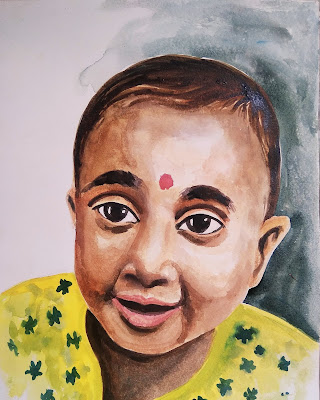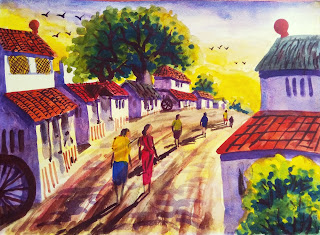Various Art Forms
Sanjhi\sMandanas\sThapa
Tribal Paintings from Chitravan
Painting by Bhil
Paintings by Gond
Paintings by Pithora
Gudna motifs are motifs found in the Gudna language.
Sanjhi
Sanjhi is linked to a festival of the same name that is celebrated by unmarried girls in both Rajasthan and Madhya Pradesh. This festival lasts sixteen days, starting on the full moon day in Bhadrapada (August-September) and ending on the new moon day in Ashwin (September-October). The Hindu calendar designates this time as pitri-paksha, or a fortnight dedicated to ancestors. Ancestral spirits are said to visit their family during this time. It's worth noting that only single women are allowed to do Sanjhi, and once married, they must stop doing so according to the custom. Despite the fact that the tale and songs associated with Sanjhi make no direct mention to ancestral devotion, the two are clearly linked. Married women who abandon their ancestral lineage to join their husband's lineage are forbidden from practising Sanjhi in their paternal households and are tasked with passing on this art form and its related ritual to their daughters who worship their dads' ancestors. Despite the many myths and songs that have been imposed on the Sanjhi ritual and image, it is reasonable to say that it originated in the worship of a female ancestral spirit or goddess and is profoundly associated with ideas of fertility and progestation. "The VrataKathas that presently accompany these schematics, stories that repeat same themes lauding the significance of the observance," PupulJayakar writes of the folk art related with vratas and ceremony. Many stories and songs have been added to the Sanjhi picture, converting her ancient form into a folk goddess who is especially dear to young girls.
Sanjhi is painted on walls that have been freshly coated with cow excrement. Various motifs are created in bas-relief with cow dung on this surface. Flowers, colourful and vivid strips of paper, and kharia are used to embellish these designs (chalk solution).Every day, a fresh motif is drawn, only to be scraped off the next. On the thirteenth day, the process of creating a full-fledged Sanjhi with all of the motifs arranged in a parallelogram with four gateways begins. Sanjhi's full-blown image is known as kilakot, which means 'fortified abode.'
Mandanas
Both Madhya Pradesh and Rajasthan have Mandanas. They are drawn on both the floor and the wall in Rajasthan, but they are mostly drawn on the floor in Madhya Pradesh. Mandana can refer to a certain type of drawing as well as the process of drawing, such as chitramandana, which means to draw or paint. Mandana is derived from the word mandan, which implies embellishment or ornamentation. Women draw Mandanas with kharia (chalk solution) and geru (red ochre). They are painted on the houses' walls and floors after they have been plastered with a clay and cow-dung mixture. Mandanas are line drawings of many gods and goddesses that are used as festival decorations. They serve as both a seat for invoking a particular deity and a symbolic depiction of the deity. They also signal the deity's presence. Mandanas are drawn on religious festivals and fasts, as well as any important domestic ceremony such as birth and marriage, or a specially arranged religious devotion. Various gods and goddesses are depicted in this work.
Thapa explains:
Thapa, in its most basic form of hand prints, may be found throughout the country, spanning time and across geographies. This art has taken on a variety of forms throughout Rajasthan, with complex meanings. In addition to the ordinary hand prints, we see iconic depictions of many gods and goddesses made during festivals and religious rites to appease specific deities, ward off disease, and ward off negative influences. Many of these illustrations are linked to various seasons. Various Mandanas and even the Sanjhi tradition are classified as sub-categories of the Thapa art form by our study collaborator. Thapas are mostly drawn by women using kumkum, sindoor, henna, ghee, and cow dung. Red, yellow, green, blue, black, and yellow are the primary colours used to create various types of Thapas. Thupas, on the other hand, are frequently drawn in a single colour, with kumkum as the primary element.
Chitravan:
We also looked into the world of Malwa and Gwalior Chitera painters. Chitravan is a type of wall painting done by professional painters, the most of whom are men, however women also paint. These paintings are created by chiteras at festivals and other religious and ritual activities. Chitravan's composition is figurative and illustrative, and it is based on religious narratives. Khyalmandana is another name for this style. In Chitravan, there are many statues of gods, goddesses, animals, birds, flowers, creepers, celestial-nymphs, and musical instruments. Clay, mineral, and vegetable colours are all readily available in the area. Gum and resin are utilised to give these colours lustre and solidity. One of the forms' hallmarks is the complex balance between figures, flowers, creepers, and other decorative motifs. Another distinguishing element of this art genre is the lack of any initial sketch or outline. Brush strokes progress from simple to complicated and magnificent designs and figures.
Chitera-auli is a well-known neighbourhood in Gwalior where chiteras live. In terms of height, attire, and adornment of the major characters, the Gwalior style differs from the Malwa style. Women painters assist at all stages of the painting process, from the preparation of colours and brushes through the actual painting process. Some women work on their own and paint at the homes of their clients during religious and ritual activities. Chiteras are compensated both in cash and in kind in this commercial art form. This form is also known as pana and is done on paper.
Gond Paintings
Paintings by Gond have a distinct style and are works of art in and of themselves. Such is the allure of Patangarh's (Dindori, Madhya Pradesh) gond paintings, where words and songs dance on canvas, colours and patterns create musical harmonies. These paintings have a one-of-a-kind style and art that captivates due to their one-of-a-kind subject. For generations, Gond painting has reigned supreme, gracing the walls of each artist's Patangarh residence. With the passage of time, however, Gond art gradually turned away from the walls of homes and toward paper and canvas.
The Gonds are India's most populous tribal group, primarily residing in Madhya Pradesh and its neighbouring states. Today, these renowned artists' works are recognised all over the world. Nature is a huge source of inspiration for the Gond community, as art can be found everywhere in nature. The delicate patterns that spread a grace across the artist's canvas are the charm of this art.
Art of the Gonds.
The Gond community creates folk and tribal art in the form of Gond paintings. These paintings are based on a topic that emphasises nature as the primary subject. Other than drawing inspiration from nature, myths and tales can also be used as a subject for these paintings.
This art form's creation method
This art genre, also known as On Line Work, is made up of painstakingly painted lines that give static images a sensation of movement. Dashes and dots are used to increase the degree of movement detail. The use of bright colours like yellow, red, white, and blue is also a unique aspect of this art genre.
Natural things such as coloured soil, charcoal, clay, plant sap, leaves, flowers, and even cow dung are used to create the paints. Due to the shortage of natural colours, artists have begun to construct these art forms using canvas and poster colours.
Each Gond painting is a work of art in its own right. These art pieces represent a modern mind, blending mystery, pattern, a variety of colours, and comedy.














































